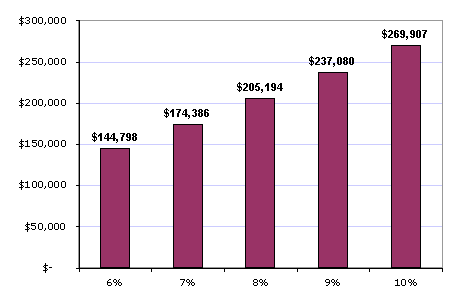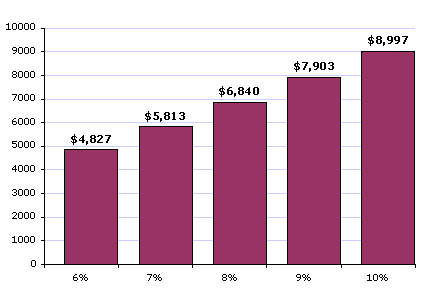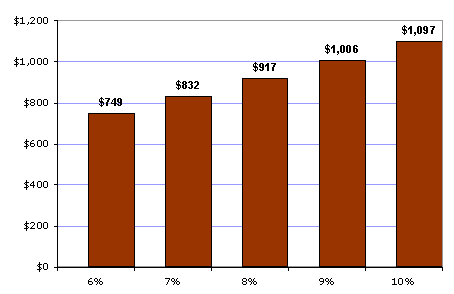(The "Mortgage")
Basics The bank loaning the money is the
lender. The amount you pay to the bank
each month is your mortgage payment. The
rate of interest on the loan is the mortgage
rate (or the interest rate). If you don't make your mortgage payments then
the bank will repossess the house. Then they'll
sell it to make sure that they can recoup the
money they loaned to you, and that you didn't
pay back. The number of years it takes to pay back the
loan is called the term, which in the
U.S. is either 15 or 30 years. There are pros
and cons of each: 15-year mortgage • Saves a bundle on
interest 30-year mortgage • Easier to qualify for How do you choose between the two? If
you want the most flexibility then take the
30-year loan. You can still save on interest and
pay your loan off early by paying the bank a
little extra each month (or whenever you can
afford it). The difference is that with a
30-year loan you get to dictate how much extra
you want to pay, and therefore how much you want
to save. With a 15-year loan you have to make
bigger payments every month whether you like it
or not. On the other hand, if you can definitely
afford the payments on a 15-year loan, and you
don't trust yourself to make extra principal
payments on a 30-year loan, then take the
15-year loan and enjoy the fact that you'll save
a bundle of interest and pay off the loan in
half the time, without having to do anything
special. If you're satisfied with that advice then
keep reading. Otherwise you can check out more
about 15- vs 30-year
mortgages in the appendix. Right now you should figure out how much
money you have saved up that you can use for a
down payment, unless you know you can get a loan
with no down
payment. Paying back a
mortgage Part of your payment goes towards the
principal (the amount the bank loaned
you), and part of it is interest (the
bank's profit from lending you money). So when
the bank loans you $100,000 you pay them back
that $100,000 and then some. If you only had to
pay back the same $100,000 they gave you then
there wouldn't be anything in it for them.
That's why they charge interest. Even though part of your monthly payment
is for principal and part is for interest, you
write only a single check to the bank each
month, and that payment amount stays the same
for the life of the loan. You don't have to
know how much of your payment is for principal
and how much is for interest, but it's usually
printed on the coupon, as well as in an
end-of-the-year statement the bank will send you
for your taxes, since you'll get to deduct the
interest you paid if you itemize. Maybe you remember percentages from high
school, so you figure that if you have a
$100,000 loan at 9% you'll be paying the bank
back $109,000? Nice try, but that's
simple interest, and banks don't work
that way. If you like you can see the appendix
about compound
interest, but all you really need to know
for now is: Here are some pretty pictures to
demonstrate the first two points. We'll
assume a $125,000 loan for 30 years at various
interest rates. So even at a very low interest rate of 6%,
you're paying $145,000 in interest on a $125,000
loan. So you borrow $125,000 and pay back
$270,000 -- more than double what you
borrowed! It's even worse if you have a higher
interest rate. Note how going from a 6% to 10%
interest rate means you pay an extra
$125,000 over the life of the loan. So the
total you'd pay on a $125,000 loan at 10% would
be $125,000 principal + $269,907 interest =
$394,907! Quite a lot to pay back for a $125,000
loan, huh? Average
Yearly Interest ($125,000 loan, 30
years) Here again, going from 6% to 10% interest
means you pay an extra $5000 on average in
interest each year! How the
interest rate affects the monthly
payment Types of
loans Conventional.
This is a fancy word for "normal". A
conventional loan is just a regular, normal
loan. FHA.
The U.S. government offers the FHA
loan program to make home-buying easier. The
government guarantees part of the loan if you
default, which means that they pay the bank if
you fail to make your payments. Since the loan
is partially guaranteed, it's easier to get.
Don't get excited about the government making
your payments for you, though -- if you fail to
make your mortgage payments the bank will still
take the house back from you. The government
pays the bank after the bank has already
repossessed your house. Note that not all
sellers will agree to an FHA loan, because
there's a little more red tape involved, and
because the house can't be a fixer-upper -- the
house has to be in excellent shape to pass an
FHA inspection. VA. VA
loans are an option for veterans, and it's
possible to put 0% down on one. Just like with
FHA loans, the VA itself doesn't lend money, it
just guarantees part of the loan so lenders feel
comfortable lending the money. VA-guaranteed
loans can be combined with second mortgages
(which is when the bank makes the main loan
covering most of the price of the house, and the
seller makes a separate loan to the buyer for
the rest of the price.) VA loans can be assumed
by any future qualified buyer, so your hands
aren't tied if you need to sell -- you can sell
to anybody, not just another veteran.
The loan you get from the bank is
called a mortgage, also called a
note. (We'll talk more about how to get a
loan in a minute.)
• Pay off the loan in half the
time
• Lower monthly payments
• Allows you to buy a
higher-priced home
• Keeps your cash liquidYou pay back your loan by making a
payment every month. The bank doesn't send
you a bill, so it's your responsibility to
remember to make the payments every month. They
do give you a cute little coupon book, with one
slip for each month, so you can include the slip
when sending in your check each month. These
days most banks also let you pay online. I
strongly urge you to set up an automatic monthly
draw from your bank account, so you never miss a
payment, and so it's one less thing you have to
worry about each month.



For the most part, you don't have to
concern yourself with the difference between the
three main kinds of loans (Conventional, FHA,
and VA loan). It's your lender's job to try
to pick the best loan for your needs and
qualifications, not yours. But since you'll hear
these terms bandied about frequently, you might
want to know what they mean, so here ya go.
